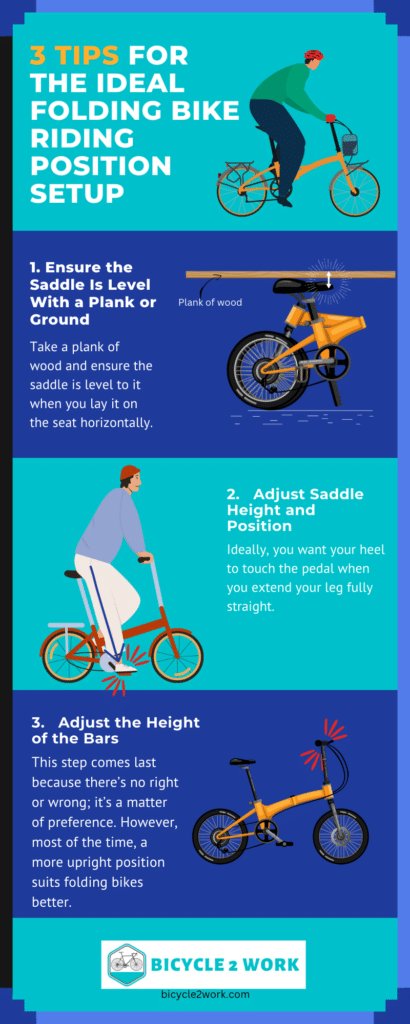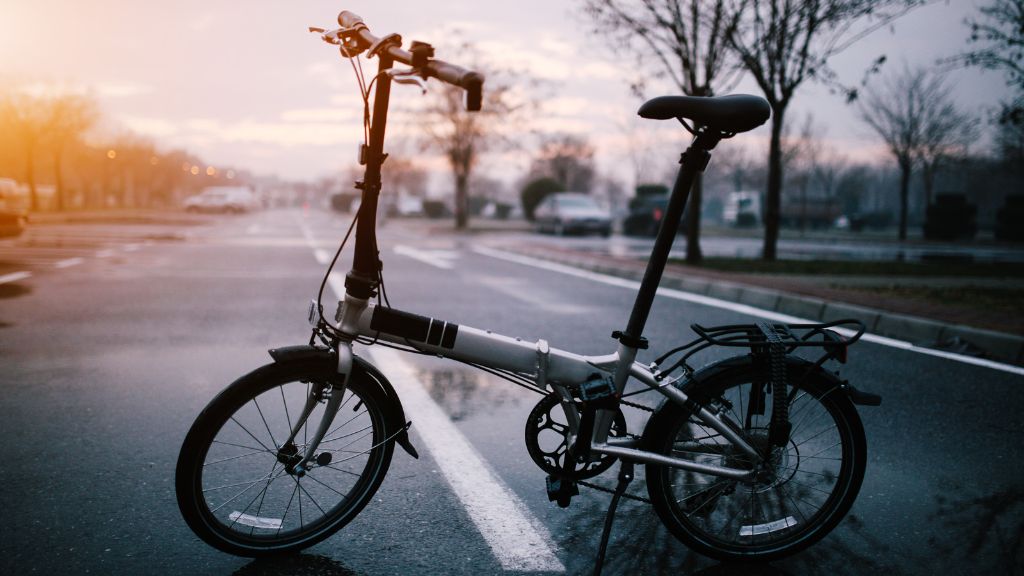This post may contain affiliate links. If you click an affiliate link and make a purchase, I may earn a commission. Also, as an Amazon Associate, I earn from qualifying purchases.--
Folding bikes are a little different than most other bike types on the market in terms of how they look, the technologies they utilize, and the way they ride.
Their practicality and versatility are two of the main reasons why they’re getting more and more popular as of late, and they’re expected to continue growing in popularity.
To ensure a good riding position on a folding bike, you want to ensure your saddle is level (horizontally), make sure your heel touches the pedal when you extend your leg fully straight, and adjust the height of your bars to be more upright.
If you have a folding bike or if you’re planning to buy one, this post is for you! We’ll be sharing a few tips on the ideal folding bike riding position, as well as covering the different types of folding bikes and their use cases.

Basic Folding Bike Riding Position Explained
When riding a folding bike, it’s important to maintain a proper riding position in order to ensure a comfortable and efficient riding experience.
The basic riding position for a folding bike is as follows:
- First, stand up straight with your feet shoulder-width apart and hands on the handlebars.
- Your arms should be slightly bent at the elbow to help absorb shock and reduce fatigue.
- Your back should be straight with your shoulders relaxed and your head up.
- Your legs should be bent at the knee and your feet should be flat on the pedals.
3 Tips for the Ideal Folding Bike Riding Position Setup
Getting the most out of your folding bike in terms of comfort and riding efficiency requires getting your riding position right.
The standard contact points are the same for just about any bicycle type you ride, whether it’s a folding, mountain, or hybrid bike. These contact points are the handlebars, pedals, and saddle.
Understanding how to adjust the distance between these contact points, such as from the saddle to the pedal, guarantees you a smooth and comfortable riding experience.
Here’s what you’ll have to adjust to make the ride smoother:
1. Ensure the Saddle Is Level With the Ground
To begin with, you need to make sure that your saddle is level with the ground when you flip the bike over on the ground.
Alternatively, you can bring a plank of wood and test whether the saddle is level to it when you lay it on the seat.
2. Adjust Saddle Height and Position
The next step is to make sure the saddle is at the right height. If it’s too high, you’ll suffer from groin/buttocks and lower back pain. Add to that, you won’t be able to touch the pedal with your heel in that case.

On the other hand, if it’s too low, your knees will suffer a lot of stress. Not to mention, it feels like you’re being pushed off the saddle every time you pedal.
Ideally, you want your heel to touch the pedal when you extend your leg fully straight.
With the fact that pedals are higher up on modern bikes, you might feel compelled to lower the saddle. However, it’s better to lean against the pavement or hop off your bike when you want to reach for the ground than to damage your knees with a saddle that’s too low.
Pro Tip
It’s worth mentioning that you should adjust the saddle relative to the pedals and regardless of the bars.
In other words, it’s not a good idea to adjust the distance from the bars by changing the seat’s position to learn forward.
Moving your seat forward to accommodate the distance to the bars puts insane pressure on your palms and causes pain to the hands and shoulders as well.
To understand this better, try sticking your back to a wall and leaning forward. It feels like you’re losing balance and falling over.
The same thing happens when you place your seat too far close to the bars. However, keep in mind that moving it too much to the back is also harmful in the long run. It causes bending in the lower back and takes away from the control you have over the pedals.

How to Get the Correct Saddle Height?
So, how do you know that your saddle height is ideal? The trick is to have a plumb bob from the knee cap pointing to the pedal axis when the pedals are level.
I also found this video quite useful for adjusting your folding bike saddle to make it most comfortable:
3. Adjust the Height of the Bars
After you’re all set with the saddle, it’s time to check on the bars. This step comes last because there’s no right or wrong; it’s a matter of preference.
You can place the bars further and lower to get a bending position. However, most of the time, a more upright position suits folding bikes better.
Here are all the 3 tips summarised in an infographic:

What Are the Types of Folding Bikes?
Folding bikes come in different sizes and styles. Some of the most popular are the following:
Compact Folding Bikes
Compact options are made for maximizing portability by being as small and lightweight as possible.
They’re an excellent choice for city dwellers looking for a bike that they can take on public transportation or in cars.

Full-Size Folding Bikes
Full-size folding bikes are the go-to for someone that wants the best of both worlds.
They’re as close as possible to full-size bikes, but give you the benefit of foldability for storage and portability for transport.
Electric Folding Bikes
Electric bikes are getting more and more popular, and folding bikes hopped on the bandwagon. They’re an excellent choice for anyone looking to travel more without getting exhausted.
Recumbent Folding Bikes
For avid travelers, folding recumbent bikes are the real deal. These bikes are some of the most comfortable ones out there, allowing you to cycle for great distances without any discomfort. All that without losing the portability and flexibility you get from a folding bike.
Benefits of Riding a Folding Bike
There are many benefits to riding a folding bike. Here are some of the most notable benefits:
1. Portability
The biggest advantage of folding bikes is how portable they are. They’re so lightweight, which makes them easier to transport and store.
So, if you’re living in an apartment studio, you won’t have to worry too much about where to put your bike when you take it upstairs.
You also won’t have to worry about the journey upstairs as your bike will be light enough to carry.
2. Affordability
Besides portability and flexibility, folding bikes are much more affordable than regular bikes.
Admittedly, they’re not as sturdy and might give you less reliable performance, but it’s a small price to pay given the space, time, and effort they help you save.
3. Versatility
Folding bikes are just as versatile as regular ones. You can use them for commutes, leisure, road biking, or even hiking like a mountain bike if you get one that’s sturdy enough.
What to Consider When Choosing a Folding Bike
There are a few factors to take into account when choosing a folding bike, namely:
1. Size
Folding bikes are small as is, which makes them a little tougher to work around when it comes to finding the ideal riding position.
So, you should make sure the bike is big enough to give you room to adjust the seat, handlebars, and pedals.
2. Weight
Since portability is the main advantage of a folding bike, you have to make sure you’re getting a bike that’s considerably lighter than a regular option.
Make sure it’s easy to carry and move around, both folded and unfolded.
3. Price
Firstly, make sure the bike is within your budget. Secondly, double-check that you can’t get a better regular one with the same amount of money.
However, you’ll probably have to pay a premium if you want a folding bike with performance that’s comparable to regular ones.
So, make sure that it’s a beast of performance or an affordable option to be getting your money’s worth.

4. Quality
Research the bike well before you buy it, as durability on folding bikes is trickier than on regular options.
They have plenty of mechanical parts, and the ones that regulate the folding are crucial. You don’t want to be about to hop on the train to find your folding mechanism uncooperative or plan a ride only to be unable to unfold it.
The brand name can be a bit reassuring here, so look for known folding bike brands like Brompton, Tern, B’Twin, and Raleigh.
5. Features
Just because its main purpose is practicality doesn’t mean that you shouldn’t look for some bells and whistles too!
Make sure you’re getting something out of the wheels, gears, frame, and more. Otherwise, look for another option that gives you more value for your investment.
Conclusion
If you’re a regular foldable bike rider, there are some tips to ensure a more comfortable ride, and we hope the ones we gave you were helpful.
Get the right saddle height, adjust the stem length and tilt, and make sure your back is parallel to the ground when riding.
These simple adjustments can help make your folding bike rides much more enjoyable as well as healthier in the long run!
